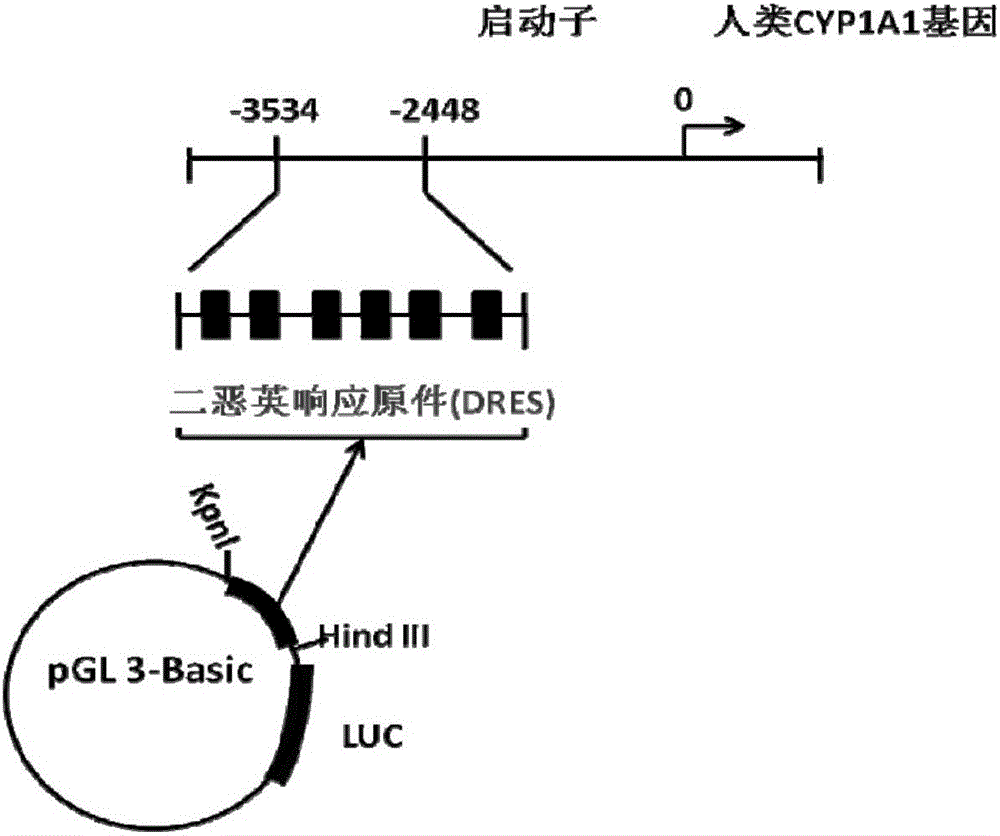Humanized recombinant vector and cell for dioxin-type substance biological detection
A technology for recombining vectors and recombining cells, applied to cells modified by introducing foreign genetic material, biochemical equipment and methods, animal cells, etc. Reflecting issues such as the impact of dioxin-like substances
- Summary
- Abstract
- Description
- Claims
- Application Information
AI Technical Summary
Problems solved by technology
Method used
Image
Examples
Embodiment 1
[0057] The construction of embodiment 1 carrier
[0058] (1) Construction of pCL-HFL vector
[0059] Human genomic DNA comes from Hep G2 cells and is extracted according to the standard method of the kit. And through the standard molecular cloning means to construct and obtain pCL-HFL ( figure 1 ).
[0060] The purpose of this experiment is to construct a dioxin reporter gene detection vector including the original sequence of the human CYP1A1 promoter (-3534~-2448), which contains 6 DRE sequences. Using human genomic DNA as a template, a PCR reaction was performed with the following primers.
[0061] The 5' primer is: CGGGGTACCGAGGCTGGCCCTTTAAGAGC (SEQ ID NO: 1)
[0062] 3' primer is: CCCAAGCTTACTGCCACCTTTATAGGCGG (SEQ ID NO: 2)
[0063] After the PCR fragment was obtained, it was digested with Kpn Ⅰ and Hind Ⅲ, and the vector pGL3-basic was subjected to the same double digestion, and finally the fragment was constructed into pGL3-basic. Finally, after identification by...
Embodiment 2
[0087] Example 2 Vector transient transfer of Hep G2 cells to obtain optimal exposure time
[0088] Hep G2 cells were treated with 1×10 5 The amount per well was inoculated into a 24-well plate, and the carrier was transiently transfected with liposomes (LTX). That is, 0.5 μg vector (pCL-HFL or pCL-HCR2 vector) plus 1 / 50 amount of pRL-SV40 (control reporter gene vector, expressing Renilla luciferase) were co-transfected into cells for 22-24 hours. The cells were cultured in α-MEM medium (1% DMSO content) with a final concentration of 10 nM of TCDD for 4 h, 12 h, 24 h, and 48 h, and treated with a medium (without TCDD) with a final concentration of 1% DMSO under the same conditions. cells as a negative control. After the predetermined time, discard the original medium, wash with 500ml PBS, add 200μl cell lysate, shake at 400r / min for 15 minutes. Then pipette 50 μl of cell lysate into a 96-well white opaque microtiter plate, and repeat 3 times for each sample. Prepare the su...
Embodiment 3
[0090] Example 3 Concentration-effect curve obtained by transiently transfecting Hep G2 cells with vector
[0091] Hep G2 cells were treated with 1×10 5 The amount per well was inoculated into a 24-well plate, and the carrier was transiently transfected with liposomes (LTX). That is, 0.5 μg vector (pCL-HFL, pCL-HCR2 or pGL6.1 vector) plus 1 / 50 amount of pRL-SV40 (control reporter gene vector, expressing Renilla luciferase) was co-transfected into cells for 22-24 hours. Aspirate the old medium to a final concentration of TCDD of 1.0 x 10 -13 ~1.0×10 -8 M TCDD's α-MEM medium (1% DMSO content) cultured the cells for 24 hours, and the cells treated with the medium (without TCDD) with a final concentration of 1% DMSO under the same conditions were used as negative controls. After 24 hours, discard the original medium, wash with 500ml PBS, add 200μl cell lysate, shake at 400r / min for 15 minutes. Then pipette 50 μl of cell lysate into a 96-well white opaque microtiter plate, and ...
PUM
 Login to View More
Login to View More Abstract
Description
Claims
Application Information
 Login to View More
Login to View More - R&D
- Intellectual Property
- Life Sciences
- Materials
- Tech Scout
- Unparalleled Data Quality
- Higher Quality Content
- 60% Fewer Hallucinations
Browse by: Latest US Patents, China's latest patents, Technical Efficacy Thesaurus, Application Domain, Technology Topic, Popular Technical Reports.
© 2025 PatSnap. All rights reserved.Legal|Privacy policy|Modern Slavery Act Transparency Statement|Sitemap|About US| Contact US: help@patsnap.com



